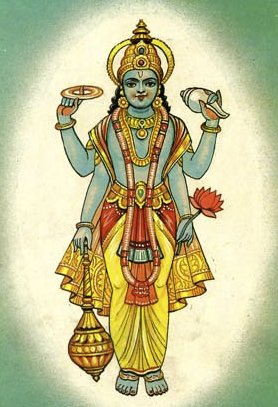Kramadipika, Kramadīpikā, Krama-dipika: 5 definitions
Introduction:
Kramadipika means something in Hinduism, Sanskrit. If you want to know the exact meaning, history, etymology or English translation of this term then check out the descriptions on this page. Add your comment or reference to a book if you want to contribute to this summary article.
In Hinduism
Vaishnavism (Vaishava dharma)
Source: Pure Bhakti: Brhad BhagavatamrtamKramadīpikā (क्रमदीपिका) refers to:—The name of a tantra. (cf. Glossary page from Śrī Bṛhad-bhāgavatāmṛta).

Vaishnava (वैष्णव, vaiṣṇava) or vaishnavism (vaiṣṇavism) represents a tradition of Hinduism worshipping Vishnu as the supreme Lord. Similar to the Shaktism and Shaivism traditions, Vaishnavism also developed as an individual movement, famous for its exposition of the dashavatara (‘ten avatars of Vishnu’).
Languages of India and abroad
Sanskrit dictionary
Source: Cologne Digital Sanskrit Dictionaries: Aufrecht Catalogus Catalogorum1) Kramadīpikā (क्रमदीपिका) as mentioned in Aufrecht’s Catalogus Catalogorum:—[tantric] L. 1551. 1645. K. 38. Bik. 590. Tu7b. 9. Rādh. 25 (and—[commentary]). Burnell. 207^a (on Gopālamantra). Quoted in Śāktānandataraṅgiṇī Oxf. 103^b.
—[commentary] by Gaṇeśadatta. NW. 198.
—[commentary] by Govindavinoda Vidyāvinodabhaṭṭa. Bik. 591. Np. Iii, 62.
—[commentary] by Bhairava Tripāṭhin. Bik. 590.
2) Kramadīpikā (क्रमदीपिका):—worship of Kṛṣṇa, by Keśavācārya. Paris. (B 153). Oudh. Xv, 130. Np. Iii, 62. Proceed. Asb. 1865, 140.
—[commentary] by Keśava Bhaṭṭa Gosvāmin. Oudh. Xv, 130.
—by Nityānanda. NW. 194.
3) Kramadīpikā (क्रमदीपिका):—[tantric] Mentioned in Āgamatattvavilāsa.
4) Kramadīpikā (क्रमदीपिका):—Tattvasamāsavṛtti. Rgb. 565-67. 571.
5) Kramadīpikā (क्रमदीपिका):—[tantric] [Bhau Dāji Memorial] 59.
—[commentary] by Viśveśvara (Paṭala 1-3), and thence by Janārdana. Stein 228.
6) Kramadīpikā (क्रमदीपिका):—by Keśavācārya. Peters. 4, 42 (and—[commentary]) inc.
7) Kramadīpikā (क्रमदीपिका):—[tantric] worship of Kṛṣṇa, by Keśavācārya. As p. 51. 52 (4 Hss.). Cr. (Paṭala 1-8). Cs 5, 16. C. Laghudīpikā. As p. 52. C. Vṛtti. Hpr. 1, 86. C. by Govindavidyāvinoda. As p. 52. Cr. C. by Mādhavācārya. As p. 52.
Source: Cologne Digital Sanskrit Dictionaries: Monier-Williams Sanskrit-English DictionaryKramadīpikā (क्रमदीपिका):—[=krama-dīpikā] [from krama > kram] f. Name of [work]
[Sanskrit to German]
Sanskrit, also spelled संस्कृतम् (saṃskṛtam), is an ancient language of India commonly seen as the grandmother of the Indo-European language family (even English!). Closely allied with Prakrit and Pali, Sanskrit is more exhaustive in both grammar and terms and has the most extensive collection of literature in the world, greatly surpassing its sister-languages Greek and Latin.
See also (Relevant definitions)
Partial matches: Dipika, Krama.
Starts with: Kramadipikasutrani, Kramadipikatantra.
Ends with: Balarcakramadipika, Lalitakramadipika, Putrakramadipika, Samkhyakramadipika, Saubhagyakramadipika, Sharadakramadipika, Vishnupujakramadipika.
Full-text: Samkhyalamkara, Putrakramadipika, Lalitakramadipika, Saubhagyakramadipika, Sharadakramadipika, Samkhyakramadipika, Gopalaka, Govindavidyavinoda, Keshava bhatta gosvamin, Bhavadipika, Keshava acarya, Gopi, Dara, Tattvasamasa, Nityananda, Dal, Gopa, Samkhya.
Relevant text
Search found 3 books and stories containing Kramadipika, Kramadīpikā, Krama-dipika, Krama-dīpikā; (plurals include: Kramadipikas, Kramadīpikās, dipikas, dīpikās). You can also click to the full overview containing English textual excerpts. Below are direct links for the most relevant articles:
Chaitanya Bhagavata (by Bhumipati Dāsa)
Verse 1.13.177 < [Chapter 13 - Defeating Digvijayī]
Verse 1.13.19 < [Chapter 13 - Defeating Digvijayī]
Verse 1.1.114 < [Chapter 1 - Summary of Lord Gaura’s Pastimes]
Brihad Bhagavatamrita (commentary) (by Śrī Śrīmad Bhaktivedānta Nārāyana Gosvāmī Mahārāja)
Verse 2.1.35-37 < [Chapter 1 - Vairāgya (renunciation)]
A History of Indian Philosophy Volume 3 (by Surendranath Dasgupta)
Part 1 - Teachers and Pupils of the Nimbārka School < [Chapter XXI - The Nimbārka School of Philosophy]